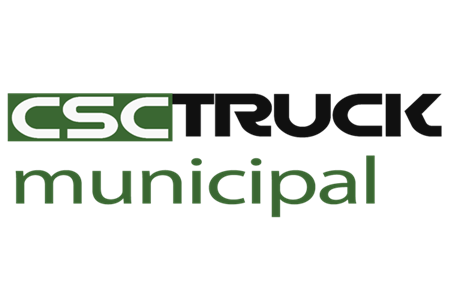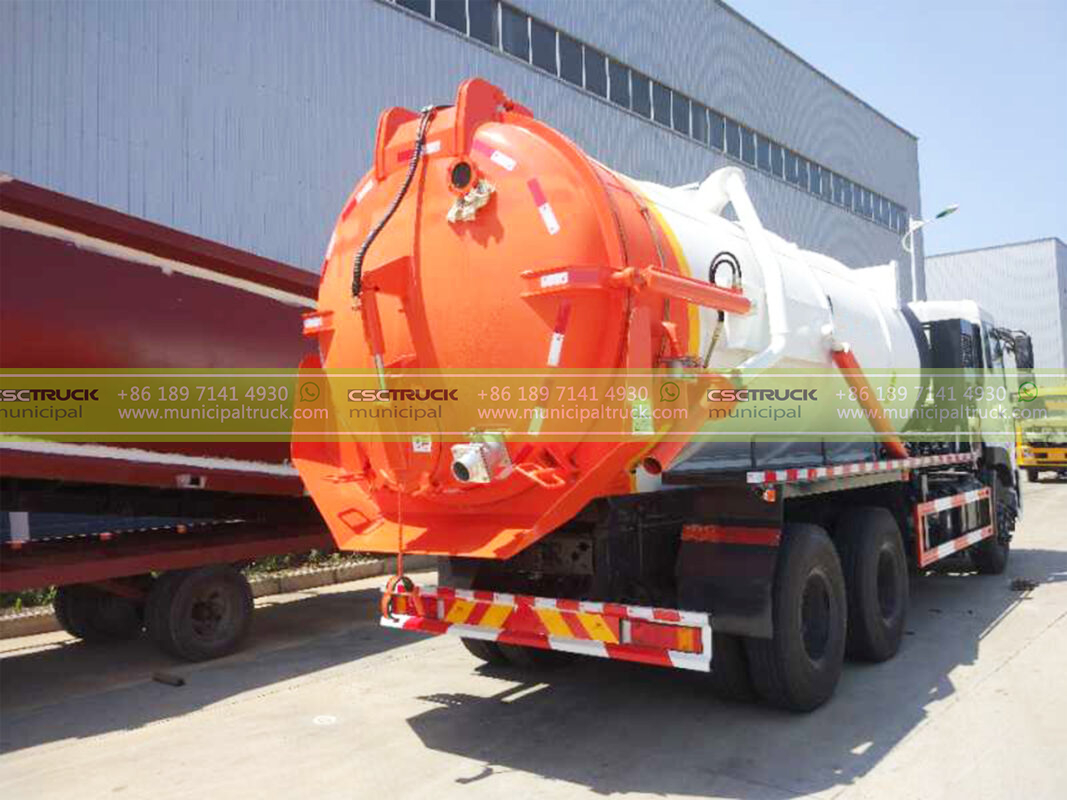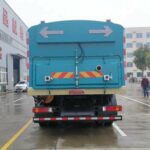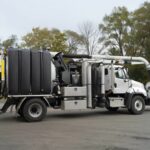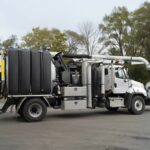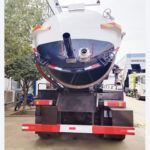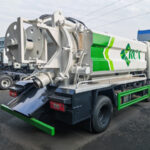Beneath the bustling streets of our cities lies a critical, yet often overlooked, infrastructure network: the sewer system. Maintaining the integrity and functionality of these pipelines is paramount for public health, environmental protection, and urban resilience. As these systems age and face increasing stress from root intrusion, grease accumulation, sediment deposition, and structural degradation, rehabilitation strategies become essential. While many tools exist in the municipal maintenance arsenal, the combo sewer jetter truck emerges as a uniquely powerful solution for complex, multi-stage rehabilitation projects. This integrated powerhouse combines high-pressure water jetting capabilities with robust vacuum loading into a single, highly mobile platform, enabling crews to address multiple pipeline issues efficiently and effectively within a single deployment window. Understanding precisely when to deploy this versatile asset is key to optimizing maintenance budgets, minimizing community disruption, and extending the operational lifespan of vital sewer infrastructure. This exploration delves into the specific scenarios and conditions where a combo truck transitions from being a useful tool to becoming the indispensable centerpiece of a successful rehabilitation campaign.
The Combo Truck Advantage – Synergy in Action
The core strength of the combo sewer jetter truck lies in its integrated design, merging two critical functions traditionally handled by separate vehicles or multiple passes:
- High-Pressure Hydro Jetting: Utilizing a powerful pump, often driven by the truck’s chassis engine or a dedicated auxiliary power unit, the system pressurizes water (typically potable water from an onboard tank or a connected hydrant) to extreme levels (ranging from 1,500 to over 4,000 PSI). This high-velocity water is directed through specialized nozzles (varieties include forward-cutting, down-cutting, and root saw nozzles) propelled via long, flexible hoses into the pipe. The intense hydrodynamic force dislodges, fractures, and flushes away a vast array of obstructions and deposits, including compacted grease, mineral scale, roots, and settled grit.
- High-Volume Vacuum Loading: Simultaneously, the truck employs a robust vacuum system, powered by a positive displacement blower or exhauster, creating powerful negative air pressure. This vacuum draws the dislodged debris, wastewater, and flushing water mixture through a large-diameter suction hose into a spacious onboard debris tank. Advanced filtration systems ensure captured water is separated from solids, allowing clarified water to be recirculated for jetting (in closed-loop systems) or responsibly discharged where permitted.
The synergy between these systems is transformative. Jetting effectively prepares the pipe wall and breaks apart blockages, while the vacuum system immediately removes the debris, preventing re-settling or downstream clogs. This closed-loop approach maximizes efficiency, minimizes the need for bypass pumping in many scenarios, and significantly reduces the environmental footprint of the operation compared to methods requiring extensive excavation or purely mechanical cleaning followed by separate debris hauling. The combo truck essentially delivers a diagnostic clean, debris removal, and preparation phase all within one coordinated operation.
Identifying Candidates – When Multi-Stage Intervention is Paramount
Not every pipe cleaning job necessitates a combo truck. However, specific conditions signal the compelling need for its integrated capabilities, particularly when rehabilitation requires sequential steps best performed in a single mobilization:
- Severe Root Intrusion: When CCTV inspection reveals dense root masses penetrating pipe joints or fractures, simple rodding or light jetting is often insufficient. Combo trucks excel here: High-pressure jetting with root saw nozzles cuts through major roots, while the concurrent vacuum immediately extracts the severed root material and accumulated sediments trapped within the root ball, restoring flow and preparing the pipe for potential cured-in-place pipe (CIPP) lining by achieving a clean, stable substrate. Leaving cut roots behind invites rapid regrowth; immediate removal is crucial for lasting results.
- Impacted Grease and Fatbergs: Accumulations of fats, oils, and grease (FOG), especially when solidified into hardened masses (fatbergs), present a formidable challenge. High-pressure hot water jetting (an option on many combo trucks) is highly effective at melting and breaking apart FOG deposits. The integrated vacuum system is then essential to swiftly evacuate the liquefied grease, suspended solids, and contaminated water before it cools and re-solidifies further downstream or within the pipe, preventing secondary blockages.
- Heavy Sediment and Grit Deposition: Pipes experiencing chronic low flow or located in sandy areas often suffer from significant buildup of sand, grit, silt, and debris. High-volume flushing alone might merely shift the problem downstream. Combo trucks solve this: Jetting fluidizes the sediments, and the powerful vacuum system immediately lifts the slurry out of the pipeline entirely. This is especially critical when sediment removal is a prerequisite for structural repairs or lining, as residual grit can compromise the adhesion of rehabilitation liners or interfere with point repair seals.
- Pre-Rehabilitation Pipe Preparation: Almost all trenchless rehabilitation methods (CIPP, slip lining, spray lining, etc.) demand an exceptionally clean and sound host pipe interior. A combo truck’s ability to perform aggressive cleaning (removing debris, roots, loose scale, grease residues) followed immediately by thorough debris evacuation and pipeline rinsing ensures the optimal surface condition is achieved for liner bonding or grouting – all verified potentially by a follow-up CCTV inspection launched from the combo truck itself using onboard reel systems.
Rehabilitation Strategies Enabled by Combo Deployment
The combo truck is not just a cleaner; it’s a foundational enabler for diverse rehabilitation techniques:
- Root Intrusion Management: Beyond clearing blockages, combo trucks facilitate root control programs. After cutting and removing major intrusions, the jetting system can be used to apply chemical root inhibitors directly into the pipe wall and surrounding soil at the intrusion points, significantly delaying regrowth and protecting the investment in subsequent repairs or lining.
- Structural Crack/Point Repair Prep: Prior to installing internal point repair seals (such as robotic-applied patches or grout-inflated packers), the exact location must be meticulously cleaned. Jetting removes debris from cracks and fractures, while vacuuming ensures the repair zone is dry and free of loose material. This precise cleaning is vital for achieving a durable, watertight seal around the defect. The combo truck creates the ideal environment for the repair materials to bond effectively.
- CIPP Lining Preparation: As the dominant trenchless method, CIPP success hinges entirely on host pipe preparation. The combo truck sequence involves: (1) High-pressure jetting to remove all deposits and biofilms; (2) Vacuum extraction of dislodged material and rinsing water; (3) Potential re-inspection via CCTV; (4) Final flushing/rinsing with vacuum recovery to ensure a debris-free, slightly damp surface ideal for liner inversion and curing. This comprehensive prep maximizes liner adhesion and longevity.
- Post-Repair Cleanup: Following many rehabilitation techniques, residual installation materials (resin overspray, grout, felt fibers, calibration hose lubricant) must be flushed from the line. Combo trucks efficiently jet and vacuum this post-installation debris, restoring the pipe to full hydraulic capacity and ensuring no new blockages are created by leftover installation byproducts.
Operational Considerations and Site Logistics
Deploying a combo truck effectively requires careful planning to leverage its full potential:
- Site Access and Setup: Proximity to access points (manholes, cleanouts) is crucial. The truck needs sufficient space for safe operation, hose deployment/retrieval, and tank access. Consider overhead clearances for the vacuum boom and potential traffic control requirements. Efficient setup minimizes downtime and maximizes productive jetting/vacuuming time.
- Wastewater Handling and Disposal: Managing the large volumes of liquid waste and solids extracted is a primary consideration. Onboard tank capacity dictates operational run time before needing to offload. Understanding local regulations for disposal (sewage treatment plant acceptance, dewatering and solids hauling, appropriate discharge permits if recirculating or dewatering on-site) is mandatory. Closed-loop water recycling systems extend operational time and reduce environmental impact but require careful management of water quality.
- Personnel Expertise: Operating a combo truck effectively demands highly trained personnel. Operators must understand jetting pressures, nozzle selection, hose handling techniques, vacuum system optimization, safe entry procedures for confined spaces (manholes), and wastewater management protocols. Recognizing the signs of different pipe conditions and adjusting techniques accordingly is vital for efficient rehabilitation.
- System Limitations: While versatile, combo trucks have constraints. Pipeline diameter (often effective from 6″ up to 36″ or more, depending on the unit), maximum hose reach (limiting the distance that can be cleaned from one access point), the severity of structural collapse, and the sheer volume of certain debris types (like large amounts of construction rubble) can necessitate supplemental approaches or different equipment. A realistic assessment of the pipe’s condition via pre-inspection is essential.
Efficiency Gains – The Economic and Environmental Case
The decision to deploy a combo truck is often justified by significant tangible benefits:
- Reduced Mobilizations: Combining jetting and vacuuming eliminates the need for separate cleaning and debris removal crews or equipment. Mobilizing a single truck versus two or three drastically cuts transportation costs, fuel consumption, and setup/teardown time.
- Faster Project Completion: The integrated “clean and remove” process happens continuously. Crews aren’t waiting for a vac truck to arrive after jetting; debris is removed as it is generated. This seamless workflow dramatically accelerates project timelines, minimizing road closure durations and public inconvenience.
- Minimized Excavation and Bypass Pumping: By effectively cleaning and rehabilitating pipes in-situ, combo trucks support trenchless methods, drastically reducing the need for disruptive and expensive open-cut excavation. The immediate removal of debris and wastewater also lessens the reliance on temporary bypass pumping systems for maintaining flow during cleaning, further reducing costs and complexity.
- Enhanced Environmental Protection: Immediate vacuum recovery of contaminated wastewater and solids prevents spills onto streets or into storm drains. Closed-loop water recycling systems conserve significant amounts of water. Reducing excavation minimizes surface disturbance, habitat fragmentation, and the carbon footprint associated with heavy earthmoving equipment and material transport. The ability to perform thorough cleaning necessary for long-lasting repairs also extends the asset lifespan, deferring the need for complete pipe replacement with its massive environmental impact.
The Municipal Imperative – Integrating Combo Trucks into Asset Management
For municipal public works departments responsible for vast and aging sewer networks, the combo sewer jetter truck represents a strategic investment in proactive infrastructure management. Its versatility makes it an indispensable tool across the maintenance and rehabilitation spectrum. Beyond emergency response for clearing major blockages, these trucks shine in systematic preventative maintenance programs, where regular cleaning and inspection prevent minor issues from escalating into catastrophic failures. Their role in capital rehabilitation projects is equally vital, providing the essential pipe preparation for trenchless lining techniques that renew pipes at a fraction of the cost of replacement. The efficiency gains translate directly into cost savings and the ability to rehabilitate more pipe miles within constrained budgets. Whether deployed as a dedicated sewer cleaner truck tackling routine maintenance blocks, configured as a specialized sewage truck handling challenging FOG removal in restaurant districts, or integrated into a large-scale municipal truck fleet supporting city-wide infrastructure renewal programs, the combo jetter/vac provides unmatched capability. Its deployment signals a commitment to maintaining clean water, protecting public health, and ensuring the long-term sustainability of the hidden arteries that keep our cities functioning. By strategically deploying this integrated technology where it delivers maximum impact – on complex, multi-stage rehabilitation tasks requiring simultaneous cleaning and debris evacuation – municipalities optimize resources and build a more resilient underground future.
